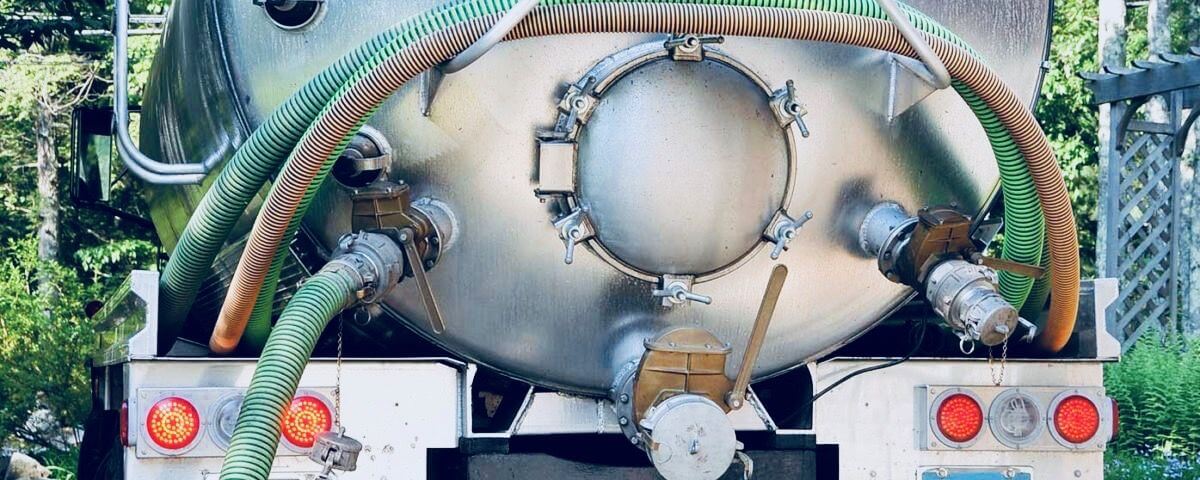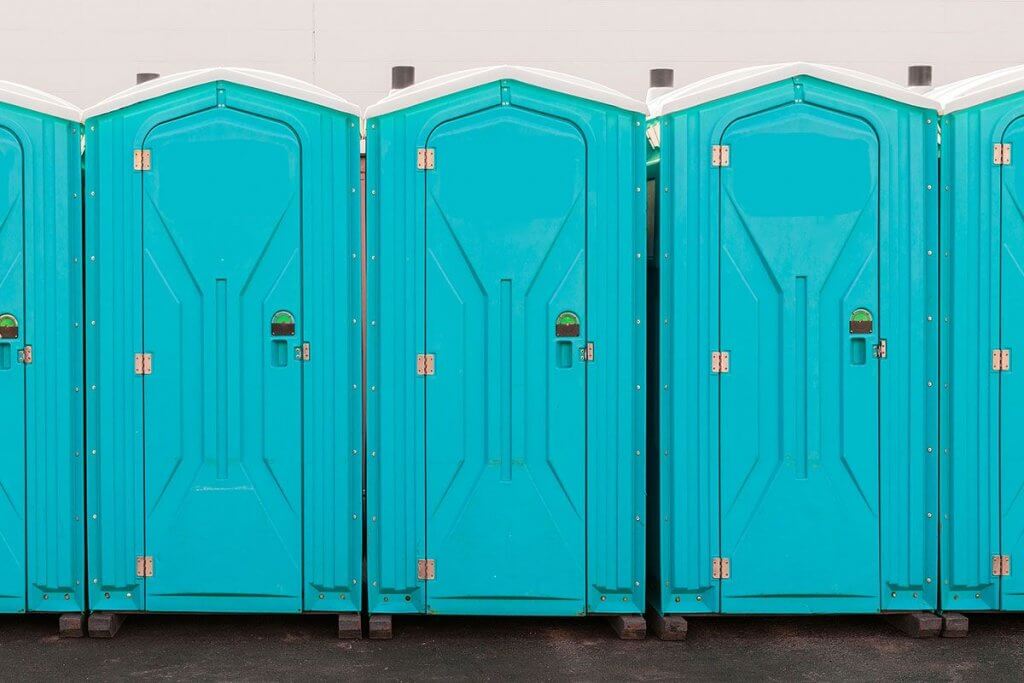
The Lab And Field-Tested Pumper Truck Exhaust Deodorant
Malodors take many forms and each type requires special methods to eradicate.
Within the portable toilet industry, scheduled unit cleanings are vital to maintaining clean, fresh-smelling portable toilets. Along with regular service, inevitably comes the reclamation of build up within the portable toilet, which can cause obnoxious smells and an endless amount of neighboring complaints if a pumper truck isn’t utilizing effective vaporous odor control products – smelly odors are quite adept at catching a ride on even the slightest of winds.
Trucks that service these units should be equipped with top-of-the-line odor-fighting tools, the most notable of which is a truck vacuum oil vapor-phase exhaust deodorant.
Recognizing long ago the absolute need for a fully effective solution to eradicate the malodorous conditions produced by the exhaust that comes from pumper truck vacuum systems, we assembled our chemists, lab technicians and chief perfumer and tasked them with creating an effective formulation to combat and ameliorate the stench that so aggressively wafts beneath the noses of both the PT operator but also the poor souls that live within proximity of any operating PT exhaust pump discharge.
The results of their efforts led to what many consider to be the most effective vaporous odor neutralizing concoction known within the PT industry. But what lab and field tests led to its formation?
Read on for a brief overview of the pumper truck industry and, more importantly, the six scientific tests that led to our creating the leading pumper truck Fresh Lube Exhaust Freshener, or contact our team today to place an order
What Causes The Odors in Portable Toilets And Pumper Trucks?
This topic is not for every day conversation especially over a meal, but it must be understood in order to analyze the problems associated with the odors that so often occur in portable toilets. It logically follows that if the ultimate desire is to make a less-odorous toilet, what causes the odors must first be understood.
Since the 19th century, scientists have believed that sulfur and amines, among other compounds, are the likely causes of the smells involving break down of human waste.
Relevant Studies and Statistics
Recent research showed that the sludgy contents of pit toilets or latrines in four countries within Africa and India contained high levels of hydrogen sulfide, paracresol, indole and butyric acid, among other stinky compounds.
The odors involved in the breakdown of human waste can be a boon to mankind in the sense that they can provide vital clues about a person’s health.
But this fares poorly when weighed against complaints about the quality of the air and lives of citizens living near odors emanating from portable toilet installations. Complaints aren’t fanciful, and often result in lawsuits, some of which turn out well and others that don’t.
One Lawsuit Against Portable Toilet Suppliers
One Washington state purveyor of portable toilets was taken to court in 2017 because nearby residents had been complaining for years about the stench emanating from porta-potties located right outside their homes.
An attorney representing a group of neighbors in a class action suit stated that the company was in blatant violation of both a state statute for nuisance and Puget Sound clean air agency regulations.
In the words of one affected mother of three children: “The smell is the same as a porta-potty standing right next to your door. It’s hard to be outside, When they’re playing outside, they have their shirts over their faces. We’re really scared about the future of the kids in the area….”
One of the four litigants filing the suit said: “The company should put themselves in our shoes because nobody wants to experience what we experience…”
Why Do PT Operators Need A Deodorized Exhaust Tube?
No matter what occasion has called for the installation of portable toilet service, the elimination of complaints from smells where these porta-potties are maintained is the top priority of installers.
Vaporous odors emanating from a pumper truck, which is equipped with a powerful vacuum that can pump liquids in and out of the tank, will travel long distances due to the increased temperature of the oil and the emission.
Pumper Trucks Are Essential To The Portable Toilet Industry
Pumper and flatbed trucks are essential to the successful operations of every company involved in the portable restroom rental industry.
Pumper trucks empty the units, and are limited in size and can only transport two standard units on the back. For the delivery of more units needed for larger events, such as festivals, open-air concerts, etc, a different type of flatbed truck is usually employed for deliveries. Standard style pumper trucks usually carry a 1,500-gallon water tank that is comprised of stainless steel, carbon or aluminum that has the ability to split water and waste in different ratios.
Although this is always a business decision based on specific needs, a common split is 300 gallons of waste with 100 gallons of water. The tank on the flat bed truck is smaller (a 500-gallon waste tank coupled with a 300-gallon water tank).
What Is A Vacuum Pump And Why Is It Important?
Simply put, in any given system, a pump is considered any device that can produce a difference in pressure between two regions of space. In a specific classification, a vacuum pump is an apparatus that creates a vacuum, which removes debris.
Removing gas molecules can only occur when there is a divergence in pressure. High and low pressure regions are so named on the basis of the number of molecules they contain. The vacuum pump removes gas molecules from a sealed volume in order to leave behind a partial vacuum.
Some important vacuum pump features include: a pressure relief valve; secondary scrubbers; filter exhaust system; automatic lubrication; access points for easy maintenance; see-though oil tank for easy level monitoring and warranties for at least one year.
The portable sanitation industry could not exist without the vacuum pump. It is essential equipment to portable restroom operators operations that greatly rely on the vacuum pumps on their trucks to keep them on schedule with their unit cleanings.
More portable toilet companies have lost clients because of poor unit servicing and the highly offensive smells that waft through residential communities than any other factor.
The vacuum pump is easy to manage, cost-effective and powerfully constructed to endure ten to fifteen years of steady use.
Development Of Our Pumper Truck Oil Exhaust Deodorant
Surco has been in continuous operation since the 1940s and our line of superior odor control products for portable toilets is well known all across the globe.
Our Fresh Lube™ Pump Oil Exhaust Freshener is the best there is, and while the original formula may often be imitated, it can never be duplicated. It is ultra concentrated and very economical because very little is utilized during operations.
Fresh Lube’s potent formulation, which includes a Cherry fragrance and odor neutralizing additive, is added to the vacuum pump oil and counteracts malodors and freshens the surrounding air, making nearby residents much happier with the proximity of portable toilet installations and minimizing the number of complaints.
This exhaust freshener has a secret weapon, an additive called Metazene that far surpasses any other odor-control products designed for controlling vaporous malodors.
This colorless, oil-based additive is particularly effective with vaporous malodors because it is a vapor-phase neutralizer, which when combined with a selected fragrance, can travel in the air as far as the malodor carries, destroying it by attacking it on a molecular level.
The foul odor molecules are heavy, and when the Metazene bonds with them, a chemical reaction occurs which causes the heavier particles to sink and eventually evaporate.
From our PT dry toss packets to our spray and wash down solution, all of our PT products contain this powerful, patented vaporous odor-neutralizing additive.
6 Lab & Field Tests That Led To Our Exhaust Deodorant
As is the case with any lab and field-tested product, there are a series of procedures that must be employed to insure the success of such products. At Surco, the following steps were employed to create the best lab and field-tested pumper truck oil exhaust deodorant on the market today.
The first procedure employed the chemist, perfumer and lab technician, all of whom participated in the creation of a panel to be used for a triangular smell test within our 80,000 square foot development research center, which includes an “olfactorium.” Each has their own specific role and function in the process and all are delineated separately. Their tests were followed by three others, and here they are:
1) The Chemists Experimentation Process
While the statement, “the chemists developed the odor-neutralizing formula,” is very true, there is much involved in this aspect of creation.
For one thing, there is no standard for measuring the intensity of odors, such as that which exists as decibels for sound and lumens for light.
Odor control is deceptive and relies on human subjective perception.
There is also a great deal of experimentation chemists must perform, as malodors must interact chemically or physically with the specific deodorant in order to be effective. How combinations of compounds affect odors requires much time and allowance for trial and error to determine.
2) The Lab Technician And The Pump Oil Formulation
The job of the lab technician is to finalize the pump oil formulation, which involves analysis and testing procedures performed via gas chromatography–mass spectrometry. This separates an aroma into component molecules.
Every chemical is then ionized so that it emits a particular electrical signal, which tells scientists exactly which chemicals are present in a scent and in what proportions.
3) The Perfumer Tests The Perfect Level Of Fragrance
The perfumer in the development process can be compared to the one who puts the icing on the cake, so to speak. It is his or her expertise in developing the perfect level of fragrance that is needed for the specific application and the compound of the fragrance itself.
This is to insure that the resulting product is powerful enough to counteract the malodorous ingredients that are often comprised of volatile gas components such as sulfides, amines, methane and other nitrogen-containing compounds that include: fatty acids; urea; ammonia; pyrrole; indole; skittle and trimethylamine.
Perfumers must seamlessly merge all the elements in a fragrance compound to maintain each of their specific functions within the final odor.
An ingredient can be there because it renders a basic aroma; modifies or adds style, freshness or diffusion to the fragrance; it blends and softens the sometimes-uneven notes, creating a successful result with depth, substance and background.
4) Surco’s Triangular Smell Test Panel
Otherwise known internally as the “triangular smell test”, this study involves the comparison of three different people and three different noses for the purpose of selecting the one sample that is different from the others.
If all three participants pick out the same sample as different, chemists know that there is actually some component they are all picking up on, albeit they can’t always define the difference.
This sniff test serves as an accurate check on odor elimination results, which are then recorded.
Three methods are utilized: headspace analysis and hedonic evaluation, whiffing of testing blotters and experimental procedures within our “olfactorium.”
5) The Simulated Vacuum Pump Exhaust Test
Surco utilized a vacuum pump that was equipped with an intake and discharge exhaust port.
The pump oil is then infused with an odor-neutralizing amalgam containing superior fragrance ingredients along with vapor-phase neutralizer additive, Metazene.
The next step involves running portable toilet liquid waste through the pump and then performing another sniff test of the exhaust fumes. This is to determine the required levels of neutralizer and fragrance that when combined to produce a satisfactory result.
6) The Field Test From The Pumper Truck Technicians
Results of this final test are determined from the end users themselves; namely, Surco’s portable toilet clients. We provided samples to a significant number of our customers to test in the field and the response was unanimously positive.
The success of Surco’s Fresh Lube Pumper Oil Exhaust Deodorant represents the cumulative effort, knowledge, skill and experience of the company’s staff of highly skilled chemists, perfumers and lab technicians. The Pumper Oil Exhaust Deodorant in the Cherry fragrance is available in pre-measured, four-ounce aluminum pour-spout cans, gallon jugs and bulk 5-gallon containers.
The Future of Surco, Portable Toilets and the Exhaust Deodorant
Surco has been a leader in the manufacture of odor control products for portable toilets for many years. Founded in the 1940s, our standard of excellence and reputation for superior customer service has remained unblemished down through the decades.
We stand behind all of our odor-control products and PT operators and suppliers can count on them to provide the best that the modern marketplace can offer.
Portable toilets are likely to remain in our midst, albeit innovations in the world of industrial science may improve their function, operations and even their appearance in future years.
As a fourth-generation family run business, Surco too, is certain to be there for future generations offering their experience, expertise and superior products guaranteed to make the world a sweeter smelling place one portable toilet armed with a pumper truck and exhaust deodorant at a time.
If you are a PT operator or supplier, consider Surco’s superior pump oil exhaust deodorizer the next time you plan an installation of portable restrooms for any occasion.





